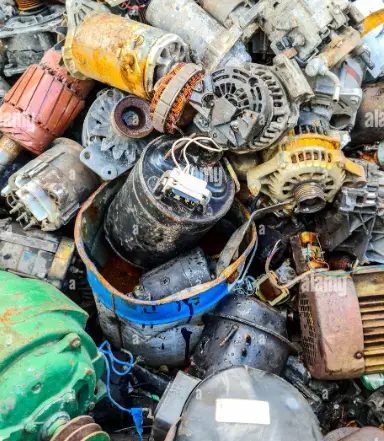What happens to scrap electric motors? If you have an electric motor that is no longer working or has reached the end of its lifespan, you might be wondering what to do with it. Electric motors are common in many household appliances, such as fans, pumps, blowers, and vacuum cleaners. They are also used in industrial machines, vehicles, and renewable energy systems. Electric motors contain valuable materials that can be recycled and reused, such as copper, steel, iron, and aluminum. However, they also pose some challenges and risks for scrapping and disposal. In this blog post, we will explain what happens to scrapped electric motors and how to do it safely and responsibly.
What are electric motors made of?
Electric motors are devices that convert electrical energy into mechanical energy. They consist of two main parts: a stator and a rotor. The stator is the stationary part that contains coils of copper wire wound around iron cores. The rotor is the rotating part that contains permanent magnets or electromagnets. When an electric current passes through the coils, it creates a magnetic field that interacts with the magnets on the rotor, causing it to spin. The spinning motion can then be used to power various machines or appliances.
Electric motors vary in size, shape, and power depending on their application and design. Some electric motors are small enough to fit in your hand, while others are large enough to power a locomotive. Other electric motors use alternating current (AC), while others use direct current (DC). Electric motors can be single-phase, while others are three-phase.
Why scrap electric motors?
Electric motors eventually wear out or break down due to various factors, such as overheating, overloading, corrosion, or physical damage. When this happens, they become inefficient or unusable and need to be replaced. However, this does not mean that they have to be thrown away or sent to landfill. Electric motors contain valuable metals that can be recovered and recycled for various purposes.
According to Tiger International Limited, a company that specializes in recycling scrap metal and electronics, scrap electric motors are fully recyclable and otherwise end up taking space in landfill. Recycling electric motors not only salvages valuable materials but also promotes sustainability by reducing the demand for new resources and minimizing environmental impact through recycling and repurposing.
How to scrap electric motors?
Scrapping electric motors is not a simple or safe task. It requires special equipment, skills, and precautions to avoid injury or damage. Electric motors can have up to 800 volts flowing through them, even after the battery has been disconnected. This poses a risk of electrocution for anyone who tries to cut or dismantle them without proper protection. Electric motors also contain powerful magnets that can attract metal objects or interfere with medical devices such as pacemakers. Moreover, electric motors use lithium-ion batteries that can be harmful to the environment and human health if mishandled or disposed of improperly. These batteries can also cause fire or explosion if damaged or exposed to high temperatures.
Therefore, it is highly recommended that you leave the scrapping of electric motors to professionals who have the necessary training, certification, and equipment to do it safely and legally. You can find authorized treatment facilities (ATFs) that accept scrap electric motors near you by searching online or contacting your local council. These facilities will ensure that your electric motor is handled according to the environmental regulations and standards.
What happens after scrapping electric motors?
After scrapping electric motors, the recyclable materials are separated and processed for further use. The most valuable material in an electric motor is copper, which is used for wiring and electrical components. Copper can be extracted from the coils of the stator by shredding or stripping them. Copper can be sold for a good price on the scrap metal market or reused for making new wires or products.
Another material that can be recovered from electric motors is steel, which is used for the casing and the iron cores of the stator. Steel can be melted down and recycled into new steel products such as construction materials or vehicles.
The magnets in the rotor can also be recycled or reused for various purposes. The magnets are usually made of rare earth elements (REEs), which are essential for many modern technologies such as smartphones, computers, medical devices, and renewable energy systems. However, REEs are scarce and expensive, so recycling them from scrap electric motors can help reduce their environmental impact and dependence on foreign sources.
More recycling of electric motors
The plastic parts of an electric motor can also be recycled or repurposed into new products such as furniture or toys. However, plastic recycling is not as common or profitable as metal recycling, so some plastic parts may end up in landfill or incineration.
The lithium-ion batteries in electric motors can also be recycled or reused, but this requires a more complex and specialized process than metal recycling. The batteries contain various metals and chemicals that need to be separated and purified before they can be reused or disposed of safely. Some of the metals that can be recovered from lithium-ion batteries are cobalt, nickel, manganese, and lithium. These metals can be used for making new batteries or other products. The chemicals in the batteries can also be converted into useful substances such as fertilizers or salts.
The recycling of lithium-ion batteries is still developing and improving, so not all ATFs may offer this service. However, some companies and organizations are working on innovative ways to recycle or reuse lithium-ion batteries, such as REEcycle, which recovers REEs from electric vehicle motors using a patented process.
Conclusion about scrap electric motors
Scrapping electric motors is a worthwhile activity that can help you make some extra money, save valuable resources, and protect the environment. However, it is not a simple or safe task that anyone can do. It requires professional skills, equipment, and precautions to avoid injury or damage. Therefore, it is best to leave the scrapping of electric motors to authorized treatment facilities that can handle them safely and legally. By doing so, you can ensure that your electric motor is recycled or reused in the best possible way.

